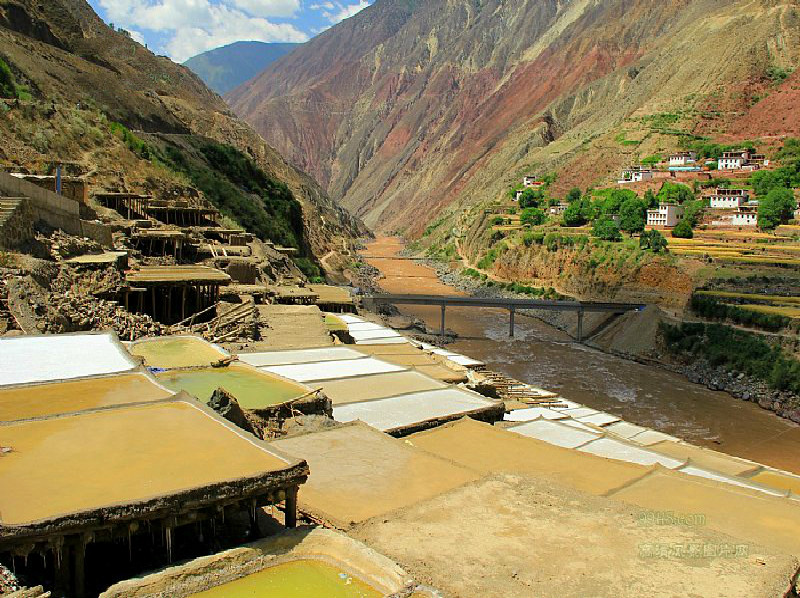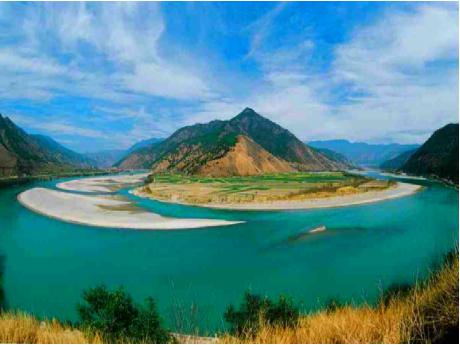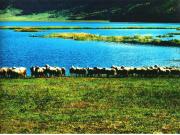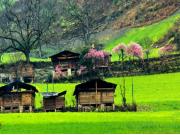滇藏线英雄路9日摄影游¥:7980元
滇藏线:214国道,丽江到拉萨,主要陆路进藏线路之一,世界海拔最高的文明文化传播古道:“茶马古道”,是多民族珍贵的历史文化遗产,是世界最然风光之最壮观,文化最神秘的旅游线路。这条线路糅合了古代和现代,大自然和都市,民俗与宗教,精神与情感,享受与修行,是从都市生活解脱出来的精神后花园。从艳遇之都丽江出发,拉市海,长江第一湾,虎跳峡,香格里拉,松赞林寺,梅里雪山,盐井,左贡,然乌湖,波密,鲁朗,林芝,拉萨,让你重走千年古道,如同穿越时光一般。
【丽江-拉萨滇藏线包车旅游】到风景美的地方,在司机确认为安全路段的情况下,可以随时停车,下车拍摄,观赏风景,全程100%纯玩无购物,吃、住、门票、车费全包,高品质自由自在旅游。
【行程概况】D1丽江-香格里拉D2香格里拉-飞来寺D3飞来寺-芒康D4芒康-左贡D5左贡-然乌湖D6然乌湖-八一D7林芝-拉萨D8布达拉宫-大昭寺D9拉萨送团(行程约4000km)
 第 1 天
第 1 天丽江-拉市海-万里长江第一湾-虎跳峡-香格里拉(中甸)-探访香格里拉民居-噶丹·松赞林寺(行程公里数:194km,行车时间约3小时)(绝世容颜)
景点:长江第一湾、虎跳峡、噶丹松赞林寺
挥别一米阳光,转角遇到爱的柔软丽江!途经拉市海赴万 里长江第一湾(约45分钟—1小时;门票:10元)(形成了罕世的“V”字形大弯,江流到此成逆转,奔入中原壮大观),那里端云缭绕、祥气笼罩,天堂一样 纯净,给予您的双眼毕生难忘的视觉体验;石鼓(古朴的木板铁索桥,人行其上,颤颤悠悠,沿江两岸的古迹、古渡,仿若走进历史长廊);零距离跨进气势磅礴的 世界峡谷之最--虎跳峡(约2—2.5小时;门票:50元)(过险滩,越断崖,水从空坠,狂涛怒卷,玉屑腾空,沙走雷霞,振撼山谷,奇险万状,令人惊心动 魄。江流最窄处,仅约30余米,江水落差约200余米,两岸雪峰高出江面3900余米),沿途观看雪山对峙、草原广阔,河谷深切、静心超然,异样的美, 随着汽车的缓行,饱涨在视线内。血红的植物,任性地布长在草甸上。这种叫“狼毒”的植物,一簇簇地在风中如燃烧的山火。田园、牛羊、草垛、沼泽、藏屋,极 目所至,尽是宁静和美。无声画卷伴随一路。
抵达香格里拉后参观云南最大的藏传佛教庙——噶丹松赞林寺(约2—2.5小时;门票:85元)(供奉五世达赖、 七世达赖时期的八尊包金释迦牟尼佛像、贝叶经、五彩金汁精绘唐卡、黄金及各种精美的鎏金或银质香炉、万年灯、传世法器等)、拜访活佛、藏经阁,静坐在此, 聆听喇嘛的天籁之音,品味人世的百味。
【用餐:早/中/晚 住宿:香格里拉 用车:旅游越野车】
 第 2 天
第 2 天香格里拉-飞来寺(纳帕海、奔子栏、金沙江月亮湾、藏乡寻访、东林寺、白茫雪山垭口、迎宾观景台、德钦、飞来寺、朝拜梅里雪山日落金山)(行程公里数:189km,行车时间约3小时)(纯美色诱)
景点:纳帕海湿地、东竹林寺
途经香格里拉最大的草原——纳帕海湿地(约1小时;门票:40元),是国家一类保护动物黑颈鹤的栖息地,是 最有高原特色的风景区之一。依拉、达拉、春珠宝草原依次排列,雪山、牛羊随草海起伏,如在海中沉浮。草原上绽放着七彩花,悠悠传来馨香土泥巴!一切都如人 们梦想中的伊甸园——香格里拉!
驱车到达茶马古道重镇——奔子栏(藏语的意思是“美丽的沙坝”。地处金沙江西岸,以上的金沙江怒涛滚滚,汹涌奔流,以下一 段江面则豁然开阔,江水平静),体悟奔子栏藏乡浮华背后的那一抹人间烟火,感受金沙江月亮湾波澜壮阔的惊叹!
朝拜藏传佛教名寺——东竹林寺(约1—1.5 小时;门票:40元)(住寺僧侣至清末已达700多人,活佛10人。褐窗密布,平顶楼房鳞次栉比,装璜富丽,彩绘纷呈,雕塑、唐卡、壁画金碧辉煌,庄严肃 穆。大小灵塔、佛塔数不胜数,跳神道具、法器一应俱全)。翻越白茫雪山白茫丫口(群峰连绵,姿态雄伟,气势磅礴,若隐若现的流水在林海中穿行,置身于其 中,仿若远方的神在召唤)!
经过梅里雪山迎宾台十三白塔,德钦县城(云南省海拔最高县城),抵达梅里雪山最佳观景台飞来寺(在遥望梅里的地方,日日夜夜接 受藏族人民的朝拜和供奉),朝拜梅里雪山日落金山(卡瓦博格雪峰耸立在语言抵达不到的清朗虚空中;望着她,那就是与神耳语。我在聆听,我在寻觅,渐渐地, 那最细微的声音和最不起眼的景象在神山的面前汇集成了一幅弘大的骇人心魄的画卷)。
【用餐:早/中/晚 住宿:飞来寺 用车:旅游越野车】
 第 3 天
第 3 天德钦-明永冰川-柔情峡谷-盐井明珠-古老制盐术-天主教堂-隐世村落-滇金丝猴家园:红拉山-达美拥雪山(神女峰)-芒康(行程公里数:204km,行车时间约4小时)(读懂滇藏)
景点:明永冰川(骑马自理)
经过澜沧江大桥, 抵达“桃源隐士”——明永村(位于梅里雪山脚下,在澜沧江河谷两岸,南对澜沧江,西靠卡瓦格博山峰。山歌、锅庄、热巴和弦子等,舞姿舒展粗犷,旋律高亢优 美,生活在神话中的民族,有着淳淳质朴的藏民俗风情)。
经明永村徒步(往返四到五个小时)或骑马赴中国最美冰川——明永冰川(约3—3.5小时;门 票:78元;如需骑马,骑马费用自理)(“世界级冰川奇观”的明永冰川,此冰川从海拔5500米的地方直冲至海拔2700米的森林地带,越靠近冰川,就越觉得自己渺小,几千米的冰 川如一幅巨大无比的苍劲的画,此时此刻就挂在眼前,由衷地赞叹着大自然的造化)。
盐井,山峰壁立千仞,草木稀少之外,岩石多为紫红色。这一带的村落同样是坐落在江边的阶地上,村庄的绿色同周围的紫红色形成鲜明的对比。晒盐的平台则搭建 在村子下面的江边,层层叠叠,犹如“茶马古道”上一颗璀璨的明珠,被称为“阳光与风的作品”。更因其世界上独一无二的古老制盐术、藏式的天主教堂、纳西民 族及当地众多的美丽传说等丰富的人文景观,而闻名于世。盐井分为上下盐井,仅有一条沟相隔,但却存在不同的宗教文化。上盐井信仰天主教,下盐井信仰藏传佛 教。盐井的两种宗教和平共处,有的一个家庭不同成员信仰不同宗教,除信仰外,生产生活一切相同,成为当地独特的人文景观。当汽车离开盐井翻越4200米的 红拉山口时,于是一个冷艳的红拉山和我不期而遇。车窗外白雪皑皑,覆盖着绵延的山体,仿佛女神的长发上披上了白色的纱巾。远眺之下,峡谷中隐隐可见彩色的 经幡,在白与黑构筑的这幅红拉山冬景图中,它们显得鲜亮而神圣。从海拔2000多米的山底,到4000多米的山巅,红拉山便是彩色的画板。高山杜鹃又填满 了峡谷、溪涧,妖娆妩媚。早听说这片森林中栖息着名为滇金丝猴的美丽动物,这是世界上唯一可以生活在海拔4000米左右的灵长类动物。红拉山是西藏境内唯 一的金丝猴生存区。
【用餐:早/中/晚 住宿:芒 康 用车:旅游越野车】
 第 4 天
第 4 天芒康-拉乌山-澜沧江-脚巴山-竹卡小镇:在感悟中痛快穿-东达山-极目雪山-唯美村寨-左贡(行程公里数:158km,行程时间约3小时)(绝色领域)
靓点:盐井、怒江、澜沧江
从芒康出发,翻越拉乌山(行车海拔4358米)下山到澜沧江边竹卡兵站、跨越蜿蜒的澜沧江,过竹卡桥翻越脚巴山、翻越川(滇)藏线上最高的山口东达山,海拔 超过5008米。仅仅比珠峰大本营低200米。 从高入云天、白皑皑的山口极目远眺,川藏公路和澜沧江似两条晶亮的丝带,在千山万壑间,时隐时现。沿途村落建筑一般是方方正正的宅子,看起来像是土石结 构,村落的外墙刷得雪白。十数栋方方正正的小房子错落有致地散落在浅褐色的山谷间,远远看起来分外干净、简洁、明快。有时候,突然看见一两栋房子矗立在陡 直的山腰上,危乎高哉!远方的路弯弯曲曲,像是故意考验着我们的意志,延伸着距离。当车行驶竹卡小镇之际,只见四周是一片苍凉的山脉,山谷中,却矗立着悬 崖般的壑壁,一条褐色的河流从远处流淌而来。我惊愕于这片褐红色,不知是山染红了水,还是水浸润了山,裸露的岩壁寸草不长,浑浊的河水义无反顾地远去,那 份烈火般的色彩燃烧着所有的过客。如此的山水,如此的地貌结构深深地印在了我的脑海里,查阅资料才知道这便是干热河谷地貌。行走的意义就是期待一种邂逅, 邂逅风景,邂逅心灵感动。
【用餐:早/中/晚 住宿:左 贡 用车:旅游越野车】
 第 5 天
第 5 天左贡-邦达草原-业拉山(怒江山)-九十九道湾(七十二拐)-怒江-澜沧江-八宿-上(下)然乌湖(行程公里数:197km,行车时间约4小时)(大美天成)
靓点:九十九道湾(七十二拐)、然乌湖
左贡出发到邦达。海拔在4400米的邦达是川藏南线和北线的交会处,北通昌都,西至林芝、拉萨,是一个重要的交通枢纽。藏东唯一的机场就建在开阔的邦达草 原,是世界上海拔最高的民用机场。告别草原,翻越横断山最大的天险——业拉山(又名怒江山)。山口海拔4839米,以下就全都是砂石路了,一路蜿蜒地下坡 到了怒江七十二拐。就这样一直下降到怒江边,路越来越窄,路面比较颠簸。玉曲迤逦而来,极尽舒缓。远处雪山连绵不尽,直至天边。在山的凹陷处,靠近河边, 依稀可见藏族村落。沿途雪山、原始森林和田园风光交相辉映,直抵绝色然乌湖。这天的行程对每个人都是一个考验。在东达山,邦达草原气温可达摄氏零度以下。 可是在澜沧江和怒江江畔气温却是20℃左右。一天经历的海拔落差起伏可近2500米。
私密体验:天脉下的传奇--上然乌湖(湖水中许多岩石和小岛点缀其 间,湖面上春季树影婆娑秋冬薄雾弥漫,四季美景都会使人如进梦幻之境;天堂一样纯净,给予您的双眼毕生难忘的视觉体验)!傍晚斜阳西下,白云、雪山、湖水 还有在草原上散布的村庄反射着光线,光与影,相生相伴;一派岁月的优雅背影,让人落寞的爱与恨。草原、佛塔、雪山、蓝天、白云,碧绿草滩上成群的牛羊以及 一块块生长着青稞和油菜的农田点缀其间,构成了一幅高原独特的壮丽风貌、又有藏区田园牧歌的风情。
【用餐:早/中/晚 住宿:然乌湖 用车:旅游越野车】
 第 6 天
第 6 天然乌湖-帕隆藏布江-米堆冰川-波密-岗乡自然保护区-古乡湖-通麦-排龙-鲁朗牧场-鲁朗林海-南迦巴瓦峰-色季拉山-八一【行程公里数:364km,行车时间约6小时】(天堂摄魄)
景点:米堆冰川【骑马100元自理】
靓点:古乡湖、南迦巴瓦峰、鲁朗林海
沿帕隆藏布江发源地然乌湖而下,帕隆藏布江可谓雅鲁藏布江主要支流之一,也是一条世界级大峡谷,平均深度相 当于1.67个重叠的科罗拉多大峡谷。峡谷内江狭山陡,江水湍急,险滩接连不断,滚滚滔滔蜿蜒咆哮于崇山峻岭之间。
米堆冰川:桃花源里的天体营(约5-6 小时徒步+拥抱冰川;门票:50元,骑马100元自理)中国最美冰川--米堆冰川,这一个雪藏深山的精灵;零距离触摸那高达七八百米从天而下的冰瀑布,气势宏伟,实属世 间少见,由衷地赞叹着大自然的造化。雪山、森林、湖泊、溪流、花海、田园,米堆就是这样的一个地方,一个只会在梦里出现的仙境。米堆村在冰川和雪山之间散 落而座,牛羊出户,鸡犬互鸣,田园阡陌,佛塔桑烟,一派胜境。米堆冰川主峰海拔6800米,雪线海拔4600米,末端只有2400米,是西藏典型的海洋型 冰川,也是世界上海拔最低的冰川,曾被评为中国最美的六大冰川之一。
抵达藏地必去的小城——波密;不去波密怎知山外有山?素来享有“绿海明珠、冰川之乡”、“西藏的瑞士”、“雪域的江南”、“旅游之胜地”的美誉,是旅 游、摄影、绘画、探索生物奥秘者的理想境地!位于帕隆藏布江惟一开阔河谷中的古乡湖,是自然美景和田园风光完美结合的典范。在这里,油画一般的风景让众多 文人骚驴赖着不走。行进在那巍峨峻峭的大山之间,那鬼斧神工、泼墨山水,那冰川绝壁、雪山云雾,令人惊叹不已。
鲁朗:犹如林中出浴的少女--鲁朗海拔3700 米,是一片狭长的高原山地,长约15公里。两侧青山由低往高分别由灌木丛和茂密的云杉和松树组成“鲁朗林海”;中间的草甸中,溪流蜿蜒,泉水潺潺,草坪上 野花怒放盛开;云雾、林海、田畴、牧场、流水、人家、牛羊。颇具林区特色的木篱笆、木板屋、木头桥及农牧民的村寨星罗棋布、错落有致,勾画了一幅恬静、 优美的“山居图”。那望不断的连绵大山,那看不够的松涛云海,那听不厌的江河奔流,凡是目睹这壮景的人,无不荡气回肠,激情飞扬。真正是雪山林海,云涛彩 霞,一岭四季,十里九景。
色季拉山:上帝打翻了调色板(翻越约2-2.5小时)登色季拉山,祥云瑞悬高罩。巍峨山脉磅礴,谁与争雄?萧瑟深秋落叶飘,层林尽染橙色满枝头。树影 斑驳连绵,横亘山脉片片。登临海拔4728米处的山口,可观日出、云海、无际的林海和远眺南迦巴瓦峰峻美的雄姿。
膜拜众山之神--云雾中的南迦巴瓦峰(约 1小时)在色季拉山山顶,遥望中国最美十大名山之冠的南迦巴瓦峰。主峰高7782米,有冰山之父的美誉。南迦巴瓦是云之上的山。这也许就像是梦,萦萦 然不可捉摸,却胜过一切目见的美。雅鲁藏布江绕山而行,造就世界第一大峡谷在此与世界第十五高峰相遇,南迦巴瓦的刚烈与雅鲁藏布的壮阔相得益彰,波涛汹涌 而下,山与水亲密融合在世界屋脊的青藏高原上造出一幅秀美的江南景致(2005年曾被《中国国家地理杂志》当选为中国最美的山峰之首)。一位诗人曾叹之, 比起珠峰的敦实厚重,我更迷醉于南迦巴瓦峰绝壁凌云的峻峭挺拔;比起希夏邦马的荒凉与干燥,我更欣赏南迦巴瓦峰的绿意婆娑与冰天雪地的有机融合;比起冈仁 波齐的遗世独立,我更眷恋南迦巴瓦峰山间那流云百转的灵动和勃勃生机。对山的所有特质作出了最完美的诠释。在柔艳林芝的旅游线上,集中了西藏江湖的精华, 每一条河流都是一条气韵独特的风景线,每一片湖泊都浓缩了自然与人文的精髓,每一处景观都有动人的传说与更动人的风情。
【用餐:早/赠送墨脱石锅鸡特色餐/晚 住宿:八一(林芝州府驻地) 用车:旅游越野车】
 第 7 天
第 7 天林芝-巨柏园-尼洋河-巴松措湖-工布江达县-松多-巴杰塘草原-米拉山-墨竹工卡-达孜-拉萨(行程公里数:489km,行车时间约7小时)(惊艳之旅)
景点:巨柏树、巴松措
巨柏园:“惊心动魄”的一树一世界(约45分钟—1小时;门票:30元)有“世界巨柏王”之称巨柏林,散 布生长着数百棵千年古柏,面积约20万平方米。古柏平均树高44米,平均直径1.58米,最大的巨柏树被誉为“中国柏科之最”,树高57米,直径5.8 米,需12个成年人合围才能抱住它,距今已有2600多年的历史。从根部向上主干被分为三根支干直冲云宵,枝繁叶茂的“柏树王”经幡环绕,洁白的哈达镶挂 其上。园内曲径通幽,峰回路转,身披经幡与哈达的千年古树们用各种千奇百怪的姿势伸展着古老而粗壮有力的胳臂,一道涓涓细流盘旋着绕过巨柏的虬根。两棵巨 树之间,远处山尖的积雪在阳光下散发着圣洁的光辉。
天使巴松措湖:人间仙境深眷恋(约1.5-2小时;门票:170元)--藏语意为“三岩三湖”,完全被 郁郁葱葱的原始森林所包围。山上白雪皑皑,山下植被茂密,巴松措长约18公里,湖面面积28平方公里,最深处达120米,湖的形状如镶嵌在高山峡谷中的一 轮新月,湖水清澈见底,四周雪山倒映其中,沙鸥、白鹤浮游湖面,湖水透明可见游鱼如织,情趣盎然。湖内有座小岛,岛上有一座古庙“错松庙”,建于唐代末 年,距今已有1500多年的历史了。殿内主供莲花祖师、千手观音和金童玉女。雪峰,冰川,原始森林,古迹将巴松措紧紧环绕,夕阳把雪山顶峰变成了红色,底 部仍然是浓重的青黛,近湖的树林剪影浮动在水面,湖水悠蓝,使这里宛如人间仙境。
尼洋河之美,美在它的水色。那个清澈,那个翡翠般的绿,那个飞溅的洁白的浪花,飞花碎玉的尼洋河。 沿途观赏尼洋河谷旖旎的自然风光,雪峰下的原始森林和如茵草场,途经巴杰塘草原,点缀其间的点点牛羊,错落有致、风格独特的藏式村寨。走进林芝,于山寨竹屋栖身,于白云山际放歌,于莽莽原林畅游、于神山峡谷纵酒,翻越林芝最后的屏障5013.25米的米拉山口,途经墨竹工卡、达孜县继续沿拉萨河谷仰望圣城佛地拉萨!
【用餐:早/中/-- 住宿:拉 萨 用车:旅游越野车】
 第 8 天
第 8 天布达拉宫-大昭寺-八角街-拉萨老城(盛宴之旅)
景点:布达拉宫、大昭寺
守望布达拉宫:抵达天国的高度(旺季法规1小时,平季、淡季约2-2.5小时;门票:淡季100元、旺季200元)松赞干布用 生命中一半的时间荡平吐蕃,用另一半时间建筑辉煌的宫殿和寺庙。“布达拉”是梵语的音译,又译作“普陀”,原指观音菩萨之居所。公元641年,松赞干布迎 娶文成公主,为公主建造了布达拉宫。布达拉宫的主体建筑分白宫和红宫,白宫是达赖喇嘛生活起居和政治活动的地方;红宫是历代达赖喇嘛的灵塔和各类佛殿,被誉为世界十大土建筑之一。布达拉宫里有房间1500余个,从唐初藏王松赞干布起,到第十四世达赖喇嘛止的 1300多年间,先后有9个藏王和10个达赖喇嘛在这里施布政教。在布达拉宫的金碧辉煌之中,我看到了一个民族的信仰的力量。你的博大,你的精髓,让我净化了灵魂,洗涤了心中的烦恼与忧怨!
大昭寺转经:阳光信徒与神佛对话 (平季、淡季约2小时;门票:85元)大昭寺,又名“祖拉康”,藏语是经堂。距今已有1350年的历史,是拉萨最古老的寺庙,至今仍然是整个藏区地位 崇高的中心寺。世上只有3尊释迦牟尼等身佛像,这三尊佛像中,大昭寺里以12岁时释迦牟尼身为皇子的鎏金铜像最为精美与尊贵。藏族人民有“先有大昭寺,后有拉萨城;去拉萨没去大昭寺就等于没去拉 萨”之说。
致命诱惑八角街:藏谜之谜(约3-4小时,无门票、无时限,自由体验)八廓街是拉萨最古老的一条街道,也就是通常所说的“八角街”。如今的八廓街既是转经道,又是一条充满民族特色的购物长廊。八廓街是拉萨乃至整个藏区人文景观的缩影,也是西藏民族文化的“百科全书”,它的一切都在默默述说着拉萨的历史。
【用餐:早/中/-- 住宿:拉 萨 用车:旅游大巴车】
 第 9 天
第 9 天拉萨送团(行程结束)
上午机场或火车站送团,愉快结束探秘云南(柔软丽江、长江第一湾、虎跳峡、松赞林寺、香格里拉、纳帕海湿地、奔子栏、东竹寺、白茫雪山、梅里雪山、世界遗 产:三江并流、明永冰川)+畅游西藏(盐井、芒康、左贡、然乌湖、帕隆藏布江、波密米堆冰川、通麦天险、鲁朗牧场、南迦巴瓦峰、色季拉山、八一、尼洋河、 巴松措湖、米拉山、布达拉宫、大昭寺、藏民家访)越野茶马古道滇藏情·英雄路极限穿越旅程!
【用餐:早/--/--住宿:-- 用车:专用接送车】
友情公示:全程旅途线路长,司机(领队)特别辛苦!当您得到超值服务之际,千万别忘随心意支付司机(领队)小费呀【建议20元/天/人】!!!
全包价格(吃、住、门票、车费全部包含)
A 标准住宿价格:
2人一台车:13280元/人
3人一台车:9880元/人
4人一台车:7980元/人
B升级住宿价格:
2人一台车:14480元/人
3人一台车:11080元/人
4人一台车:9180元/人
全包价格包含:
1、住宿:
A 标准住宿:香格里拉、飞来寺、八一、拉萨旅游酒店标准间,芒康、左贡、然乌湖当地招待所,共8晚住宿。(入住指定酒店或同级酒店,全程不提供自然单间,如出现单男单女自补房差或尽量按排拼住)游客选择A或者B住宿标准。
B 升级住宿:香格里拉、八一、拉萨四星级酒店,飞来寺 、芒康、左贡、然乌湖旅游酒店标准间,共8晚住宿。(入住指定酒店或同级酒店,全程不提供自然单间,如出现单男单女自补房差或尽量按排拼住)
2、旅游车:云南--西藏段全程用车为正规旅游越野车;市内1游为旅游大巴,送机为专用接送车。
3、门票:全程所列景点门票费用 。
4、导游:云南至拉萨段以自然风光为主,无专职导游;市内1游配中文导游。
5、保险:旅行社责任险30万/人+50万/人旅游车座位险。 (建议购买个人旅游意外险)
6、餐费:行程共计8天用餐(早/中/晚),100元/人/天,标准团队餐(赠送一餐墨脱石锅鸡特色餐);【如遇饮食习惯差异或餐馆无法安排团餐,默认退回餐费自行安排就餐。早餐大部分酒店含,司机餐费,不用游客负责】
7、购物:全程纯玩无购物。
8、费用不含:个人消费(骑马)、自愿参加的自费娱乐项目、自愿增加景点等。报价不含:自费项目、加景点费用、个人消费。
租车价格(吃、住、门票不含):19800元/台(租车不含第8天行程)
租车价包含:
1、交通:正规旅游越野车(4人/台)。
2、保险:旅行社责任险30万/人+车位险50万/人。
3、司机:全程配司机驾驶
4、导游:本行程以自然风光为主,无专职导游
5、油料:包含本行程所用的油料费用
租车价不包含:
1、门票(行程中所列景点门票价格可供参考)
2、用餐(本俱乐部司机可安排团餐,50元/人/正餐)
3、住宿(本俱乐部司机可安排住本俱乐部合作酒店,付本俱乐部协议价格)
4、自费项目、加景点车费、个人消费
【贴心服务】
1、在西藏越野车俱乐部官方网上预定本行程,西藏越野车俱乐部提前十天邮寄红景天胶囊。提前五天服用,有助于抗高原反应。
2、预定本行程,西藏越野车俱乐部赠送随车钢瓶氧气罐1瓶/团(6-8小时供氧量)。
【特别说明】
1、因进入雨季,滇藏线路况不稳定,如遇泥石流塌方等不可抗力因素,导致行程无法按照以上行程正常安排完成,绕路或者等待道路修通等解决方案,所产生的本行程外的费用,需游客自己承担,本公司不承担任何赔偿责任。超出行程天数所产生的本行程外的费用(如吃、住费用),须游客全额承担。超出行程天数车费按1200元/天支付(由游客承担),如中途游客自行终止合同,费用不予退还。
2、因滇藏线修路,实行交通管制,出发时间由司机根据交通管制时间调整,可能路上因交通管制,无法通行,需等待几小时。3、出门旅行都有一定的危险性,请游客充分考虑这一点。游客在旅行过程中,参加各种活动时应该注意人身及财产安全(例如:登山、游泳、泡温泉、骑马等自娱活动),如果因自身原因出现人身及财产损失,将按有关保险条例由保险公司进行赔偿;本公司不承担另外的赔偿责任。
一、外宾及台湾游客旅藏的有关规定
鉴于西藏特殊的民族传统、文化古迹和生态环境保护的需要,同时也因西藏的交通状况和旅游服务设施及接待能力,政府规定非中国公民身份持有者,即外国旅游客人,台湾游客及海外华人(香港、澳门居民持中国特区护照或回乡证者除外),在进入西藏旅游前,必须办理由西藏自治区旅游局[TTB]签发的“外国人入藏旅游批准函”,同时,也规定外国记者和外交官不能以旅游者身份进藏。
二、办理入藏手续前准备
凡持外国护照,台胞证,进藏旅游的游客,需先在西藏越玩越野旅游网(www.tibet4wd.com)上选定旅游线路行程,告知详细进出拉萨交通工具及时间,经西藏越玩越野旅游网上客服编排好行程,双方确认后开始办理入藏手续。我俱乐部办理入藏证件时.需报批您选择的旅游线路,抵达拉萨后是按报批旅游线路游玩西藏,不可随意更改行程,整个行程由我俱乐部安排,外宾及台湾游客只能独立成团,不能参加拼团旅游。
三、申请入藏函手续:
1、护照及签证
除了与中国有互免签证的国家之外,外国及台湾旅游者到西藏必须持有有效的护照及中国大使馆签发的签证。旅游者在当地中国大使馆可凭护照办理中国旅游(“L”)签证。
如果您所持的签证是商务(“ F ”)签证,该签证属于在中国的工作签证,办理入藏函的话,必须要有您所在的中国单位开具的证明方能办理(必须是打印的证明,不能手写),建议最好办理旅游签证,旅游签证则无需再办理相关证明。
2、办理入藏函
外国或者台湾游客需将本人护照的一页和签证第一页,扫描后用邮件或QQ电子版发至邮箱tour@tibet4wd.com或者qq 1454398359(必须确保上面每个字都能清晰辨认)。您会在2-4个工作内得到入藏的有关确认手续。为了确保您的入藏手续可在您入藏前及时送达,建议提前20日委托我俱乐部办理。
如需飞机进藏,需要提前快件邮寄进藏函给本人。如是火车入藏,西藏越玩越野会提前把入藏函扫描件发至您的邮箱,打印出来既可以火车入藏。
四、藏地旅游业界攻略指南
1、有严重高血压、心脏病患者不宜去西藏,请不要带严重的感冒进藏。
2、西藏地处高原,大部分客人会或轻或重有高原反应,只要注意休息饮食得当(切勿吃的太饱,增加肠胃负担);可适当服用一些药品,如:高原安、红景天、诺迪康等,严重者可适当吸氧或吊盐水。
3、由于西藏线路长,许多时间是在车上,难免不能按时吃饭,请客人带一些零食及饼干。
4、由于西藏条件特殊,故请客人注意自身保暖,第一天请尽量不要洗澡,洗澡会加速血液循环,增加身体对氧气的需求。
5、西藏日照强烈,气候尤其干燥,防晒霜、墨镜、润唇膏等必不可少。
6、由于西藏的特殊情况,拉萨、日喀则、林芝、山南整个餐的风味以川菜为主,但也可根据客人的口味适当调配。
7、西藏主要地区海拔:拉萨3650米;八一2900米、林芝3040米、波密2750米、墨脱1225米、朗县3100米;日喀则3860米、江孜3977米、亚东2300米、定日4410米、绒布寺5100米、珠峰8844.43米、樟木2100米;羊卓雍湖4488米,山南(泽当)3580米、拉姆拉措5000米;萨嘎4502米、普兰4216米、狮泉河4279米、改则4350米、冈仁波齐峰 6638米、玛旁雍措4588米;纳木措湖4770米;那曲4507米;然乌湖3807米、昌都3200米。
1、进藏前:
心理准备:良好的心理素质是克服和战胜高原反应的灵丹妙药。大量事例证明,保持豁达乐观的情绪,能够减弱高原反应带来的身体不适。
身体准备:进藏前睡眠和休息要充足。适当服西洋参等,以增强机体的抗缺氧能力。
随身物品:高原海拔高日照强烈,早晚温差大,需准备长袖衣裤、羊毛衫、夹克衫,同时带好墨镜、太阳帽、防晒霜、润唇膏、感冒药、肠胃药、阿斯匹林、安定等物品。
不要惧怕高原反应,只要身体健康,没有高血压,心脏病,肺病,没有感冒,咳嗽,发烧等症状的人,都不会有很大的反应。一般来说过1--2天后,以上症状都会逐步减轻或消失。
2、旅途中:
适量饮用酥油茶、奶制品和牛羊肉可增强对高原气候的适应能力。 可多吃蔬菜、水果、多喝水,最好不饮酒。在高原旅游宜穿宽松、保暖的衣服。
西藏属特殊地区,请团友和睦相处,尊重民族地区的文化和信仰习惯。 温馨提示:建议个人准备牙刷、毛巾等洗漱用品,拒绝使用酒店一次性洗漱用品,降低白色污染。提倡携带个人餐具,拒绝使用一次性筷子。 个人准备:防水冲锋衣裤(或可替代衣物,如:雨披)毛衣、或保暖内衣裤、羽绒服(用于高海拔地区,如山口早晚温差较大)袜子及内裤若干(因路途期间能否洗衣不定,最好准备些方便更换)旅行鞋,水壶,雨衣, 太阳镜、防晒霜、遮阳帽,洗漱用品,自用药品相机/胶卷/笔记本/手电
五、猎途禁忌 面面大观
NO1 藏族最大的禁忌是杀生,受戒的佛教徒在这方面更是严格。虽吃牛羊肉,但他们不亲手宰杀。藏族人绝对禁吃驴,马肉和狗肉,有些地区也不吃鱼肉。
NO2 喝酥油茶时,主人倒茶,客人要待主人双手捧到面前时,才能接过来喝,忌用单手接递物品。
NO3 行路遇到寺院,玛尼堆,佛塔等宗教设施,必须从左往右绕行,信仰苯教的则从右边绕行。 不得跨越法器,火盆。
NO4 经筒,经轮不得逆转。
NO5 忌讳别人用手触摸头顶。
NO6 进寺庙时,忌讳吸烟、摸佛像、翻经书、敲钟鼓。对于喇嘛随身佩带的护身符、念珠等宗教器物,更不得动手抚摸;在寺庙内要肃静,就座时身子要端正,切忌坐活佛的座位。
NO7 忌用有藏文的纸当手纸或擦东西。
NO8 步入藏民的帐篷、居室,不可用脚踩门槛,男的坐左边,女的坐右边。
NO9 藏民伸舌头,是表示尊敬而并非嘲笑;合十则是一种礼节。
NO10 忌讳用手指去指佛像、唐卡、经书和壁画,要用手掌向上平指以示敬意。
NO11 忌讳用有裂缝、缺口的碗、杯,认为这些已破损了的东西会阻挡福运。
NO12 藏历新年的正月初一,忌讳扫地、哭泣、骂人、吵架,忌讳说“空”、“完了”、“死”、“病”、“杀”、“没有”、“穷”、“烧”、“水冲”、“地震”等不吉利的词语,认为这样会影响全年的吉祥安康。
NO13 在大雅之堂喝酒时,首先用无名指在杯中蘸酒向空中弹三次,以示敬佛、敬法、敬僧。
NO14 禁忌当著父女、母子、兄姐、弟妹、祖孙二代谈论男女之事。
NO15 家中有病人、生小孩时,门口放火堆、挂红布,垒石头,插柏枝,这些都是忌讳客人入内或喊人的象征。主要的生怕外人带邪气进来,对病人和产妇不利。
NO16 在丧葬期间,家人来客不宜出笑声,在四十九天之内,邻居、村子不办喜事、不歌舞,不举行任何娱乐活动,以示对死者家属的尊重。有的藏区为了寄托对死者的哀思在七七忌日内不洗头,不著新衣,不戴项链等饰品。
NO17 关于天葬:西藏政府和旅游机构都不鼓励游客去看天葬,藏族人尤其是死者家属,不愿汉族人观看。如果您有机会见到,请自重您的言行。
六、触摸高原本色 享受圣地阳光
与高原厚土的联结--于是有了力量;与极地低空的联结--于是到了天堂。
西藏--天地相联的地方,走进西藏,走向阳光,于是至高无上。多彩的西藏,夏有夏的韵味,冬有冬的魅力。冬无严寒,夏无酷暑,一年四季均适合旅行。
拉萨:地处西藏中部河谷地带,全年日照达3007小时以上,平均日照达7.4小时,是世界上著名的“日光城”。即使在最冷的冬节,白天的气温也高达10--15摄氏度。
日喀则:属高原温带半干旱季风气候区。干湿季明显,夏季温和湿润,降水集中,冬季寒冷干燥多风。平均温度8℃,1月份均温-3.2℃, 7月份均温14.3℃,年日照时数3248小时。
山南:平均海拔3700米,全年日照时间长,年平均温度为5℃--10℃度。
林芝:西藏海拔最低、气候最温暖湿润、是进入西藏旅游的适应的生态腹地。形成了夏不酷热,冬不严寒的独特气候,素有“雪域江南”、“人间香巴拉”、“生态绿洲”、“高原氧吧”等美誉。
那曲:属高原亚寒带半干旱季风型气候,其特点是气温低、空气稀薄、大气干洁、太阳辐射强、日温差大。年平均气温3℃--8℃,气温平均日差16.1℃。4至11月相对温暖,是草原的黄金季节。
阿里:年平均气温3℃,夏季平均气温13.6℃,阿里地区海拔5000米以上的地方,日均温差很大,8月白天气温为10摄氏度以上,而夜间气温降至摄氏零度以下,一定要带好足够御寒的衣物。
特别提示:每年的4--11月份比较适合观光游览。阿里是西藏乃至全国基础设施最差、路况最坏的地区。拉萨至阿里走南线单程约1600公里,路况不稳定的时段只有越野车才能通行。
非常不错的旅游,好评!
挺正规的旅游公司,正规的旅游车,司机的服务特别好,一路玩儿的很开心,滇藏雨季路况不太好,司机经验充足,让我们行程安排的很合理。高师傅,值得推荐,越野车俱乐部也值得推荐。




























 .藏公网安备54010002000116
.藏公网安备54010002000116
 官方微信客服
官方微信客服